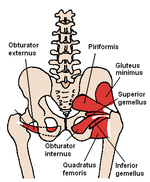
Obturator sign
Encyclopedia


Obturator internus muscle
The obturator internus muscle originates on the medial surface of the obturator membrane, the ischium near the membrane, and the rim of the pubis.It exits the pelvic cavity through the lesser sciatic foramen....
.
The technique is carried out on each leg in succession. First the patient lies on his back with the right hip flexed at 90 degrees. The examiner then holds the patient's right ankle in his right hand. With his left hand, the examiner rotates the hip by moving the right knee inward. This is flexion and internal rotation of the hip.
In the clinical context, it is performed when acute appendicitis is suspected. In this condition, the appendix becomes inflamed and enlarged. The appendix may come into physical contact with the obturator internus muscle, which will be stretched when this maneuver is performed on the right leg. This causes pain and is an evidence in support of an inflamed appendix.
The principles of the obturator sign in the diagnosis of appendicitis are similar to that of the psoas sign
Psoas sign
The psoas sign is a medical sign that indicates irritation to the iliopsoas group of hip flexors in the abdomen, and consequently indicates that the inflamed appendix is retrocaecal in orientation...
.
Evidence shows that the Obturator Test does not adequately diagnose appendicitis. (McGee 2007).

